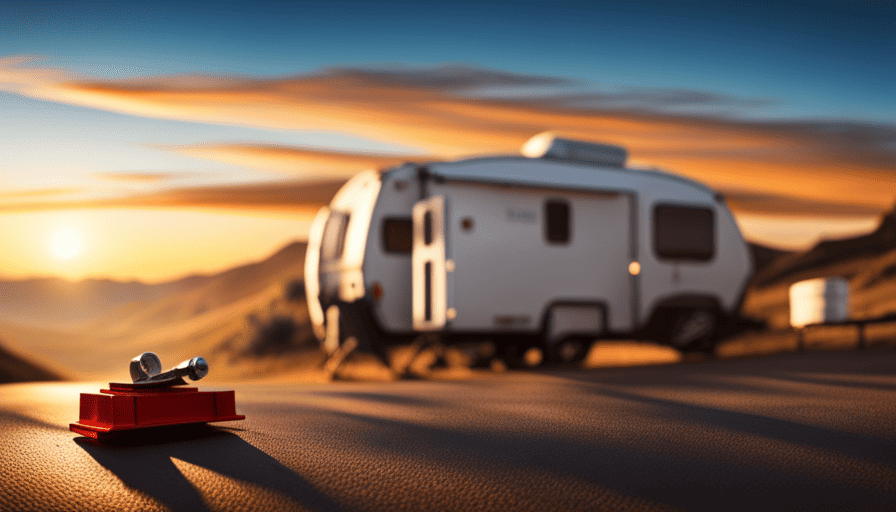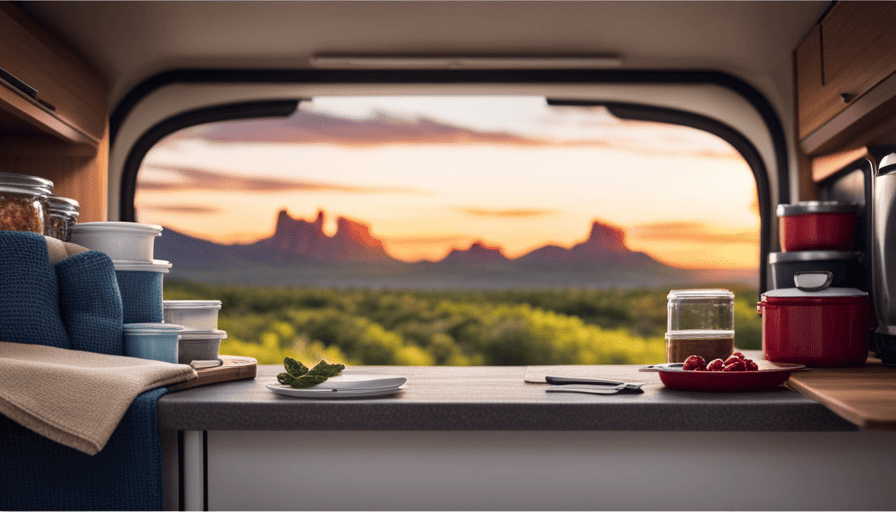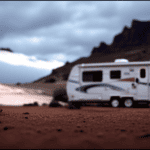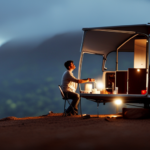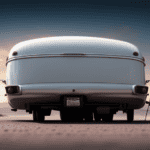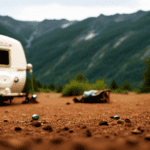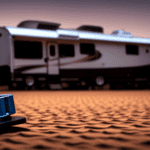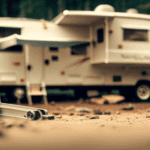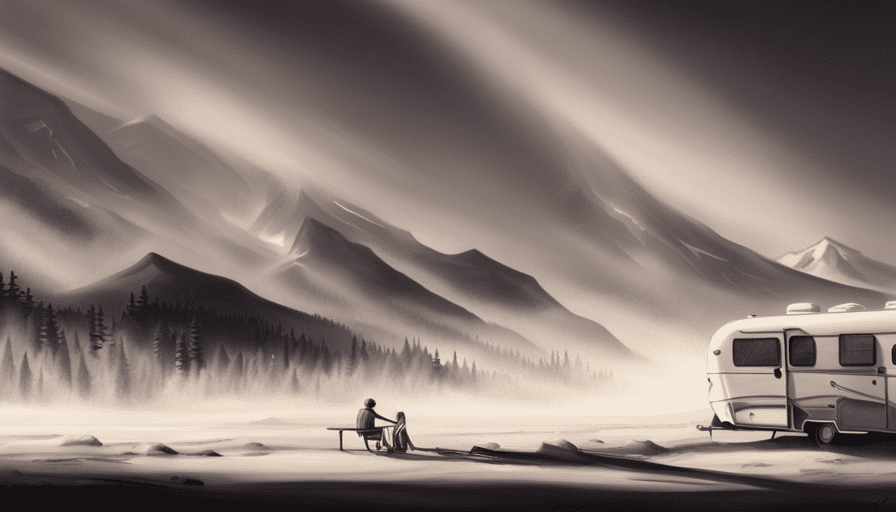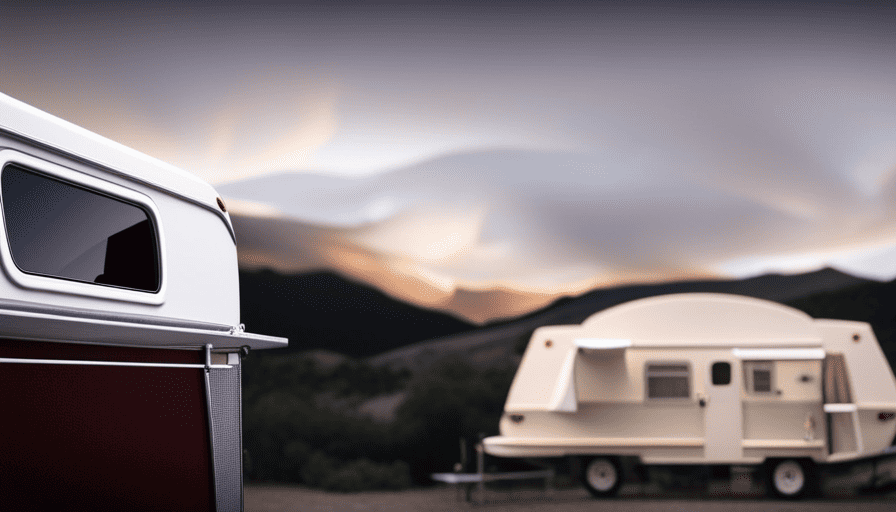Fed up with your camper rocking and swaying every time you enter or shift your weight? We totally understand your irritation, but don’t worry, fellow outdoor enthusiasts! We’ve got the perfect guide to help you stop that troublesome shaking once and for all.
Picture this: you step into your camper after a long day of outdoor adventures, only to be greeted by a rocking and unstable interior. But with our tried and true techniques, you can transform your camper into a stable and secure haven.
From securing your stabilizer jacks to using leveling blocks and wheel chocks, we’ve got you covered. Our knowledgeable and practical tips will not only prevent your camper from shaking but also enhance your overall camping experience.
So, grab your tools and get ready to say goodbye to that unwelcome rocking motion for good!
Key Takeaways
- Secure stabilizer jacks to prevent shaking while camping.
- Use leveling blocks or pads for extra support and prevent wobbling.
- Stabilizing bars or locks enhance camper stability and reduce noise.
- Proper weight distribution inside camper creates a stable environment.
Check and Secure Your Stabilizer Jacks
Make sure to check and secure your stabilizer jacks to prevent any shaking while camping. Stabilizer jack maintenance is crucial for a smooth camping experience. Before setting up your camper, take a few minutes to inspect the jacks for any damage or wear. Look for loose bolts, bent components, or signs of rust. If you notice any issues, it’s important to address them before attempting to stabilize your camper.
Once you have confirmed that your stabilizer jacks are in good condition, it’s time to properly install them. The importance of proper stabilizer installation can’t be overstated. Begin by positioning the jacks on solid ground, ensuring they are evenly spaced and aligned with the camper’s frame. Use a level to check for any unevenness and make necessary adjustments. Next, lower the jacks until they make firm contact with the ground, but avoid overextending them as this can cause instability.
By following these steps, you’ll greatly reduce any shaking or movement in your camper. However, if you need additional stability, consider using leveling blocks or pads. These can be placed under the jacks to provide extra support and prevent any wobbling. With the stabilizer jacks checked and properly installed, and the use of leveling blocks or pads if necessary, your camper will be more stable and secure, ensuring a comfortable camping experience.
Use Leveling Blocks or Pads
Utilize leveling blocks or pads to help stabilize your recreational vehicle and eliminate excessive movement. When it comes to keeping your camper from shaking, using alternative methods such as leveling blocks or pads can be a game-changer.
These handy tools provide additional support and stability, making your camping experience much more enjoyable. Leveling blocks are typically made of durable materials such as plastic or wood and come in various shapes and sizes. They can be placed under your RV’s tires or jacks to even out uneven terrain and prevent rocking or swaying. Simply position the blocks where needed, drive or back your camper onto them, and voila! Your RV will be securely positioned.
Another option is to use leveling pads, which are similar to blocks but offer a larger surface area for stability. These pads can be placed under your stabilizer jacks or other areas that require additional support. Using technology in this way ensures a solid foundation, reducing the chances of your camper shaking or moving excessively.
By utilizing leveling blocks or pads, you can effectively stabilize your RV and minimize unwanted movement. However, if you’re looking for even more stability, the next step is to install stabilizing bars or locks. These additional measures will further enhance your camper’s stability and provide a secure environment during your travels.
Install Stabilizing Bars or Locks
Once installed, stabilizing bars or locks secure your RV, providing a firm and steady foundation for worry-free travels. These stabilizing techniques are essential for camper stability, especially when parked on uneven terrain or during strong winds. Here are four key benefits of using stabilizing bars or locks:
-
Enhanced Stability: Stabilizing bars or locks eliminate the side-to-side movement of your camper, preventing it from swaying and shaking. This ensures a comfortable and safe environment inside your RV.
-
Reduced Noise and Vibrations: By minimizing the movement of your camper, stabilizing bars or locks also reduce the noise and vibrations that can be felt inside. You can enjoy a peaceful and undisturbed sleep, even in areas with heavy traffic or loud surroundings.
-
Easy Installation: Stabilizing bars or locks are designed for easy installation and removal. They can be quickly set up and adjusted to fit your RV’s specific requirements, providing immediate stability.
-
Compact and Portable: Many stabilizing bars or locks are compact and lightweight, making them easy to store and transport. You can easily carry them in your RV and use them whenever needed.
Investing in stabilizing jacks or tripod stands is the next step to further improve the stability of your camper. These additional measures provide additional support and prevent any unwanted movement.
Invest in Stabilizing Jacks or Tripod Stands
Investing in stabilizing jacks or tripod stands will greatly enhance the stability of your camper, providing a rock-solid foundation that will give you peace of mind during your travels.
While stabilizing bars and locks can help reduce shaking, stabilizing jacks or tripod stands offer even more stability. These alternatives to traditional stabilizing methods are designed to minimize movement and vibrations inside your camper.
Stabilizing jacks are durable supports that can be attached to the corners of your camper. They’re adjustable, allowing you to level your camper and provide additional stability.
Tripod stands, on the other hand, are portable and can be easily set up underneath your camper. They offer excellent stability and are especially useful on uneven surfaces.
If you prefer a DIY approach, there are several stabilizing solutions you can try. One option is to use wooden blocks or leveling ramps to support your camper’s weight. Another option is to install stabilizing plates or pads underneath your camper’s tires. These homemade solutions can help reduce shaking and provide a more secure base for your camper.
Investing in stabilizing jacks or tripod stands is a practical and effective way to prevent your camper from shaking. However, it’s also important to use wheel chocks to prevent movement when your camper is parked. By incorporating these additional measures, you can ensure a stable and secure camping experience.
Use Wheel Chocks to Prevent Movement
To keep your camping experience secure and steady, use wheel chocks to prevent any unwanted movement. Wheel chocks are simple yet effective tools that prevent your camper from rolling or shifting while parked.
Here are three reasons why wheel chocks are essential for proper storage and camper maintenance:
-
Stability: Placing wheel chocks on both sides of your camper’s tires creates a firm grip on the ground, preventing any accidental movement caused by wind or uneven terrain. This ensures that your camper remains stable and secure, minimizing the risk of damage or accidents.
-
Safety: Properly securing your camper with wheel chocks reduces the likelihood of accidents when entering or exiting your camper. It provides stability, giving you peace of mind knowing that you won’t encounter any unexpected movement while inside.
-
Longevity: By using wheel chocks, you protect your camper’s tires and suspension system from unnecessary strain. This helps maintain the quality and functionality of your camper, prolonging its lifespan and reducing the need for costly repairs.
By incorporating wheel chocks into your camping routine, you ensure proper storage and camper maintenance. Once your camper is securely chocked, it’s time to focus on balancing the weight distribution inside.
Balance the Weight Distribution Inside the Camper
Ensure that you distribute the weight inside your camper evenly to create a stable and secure environment that will enhance your camping experience and make you feel confident in your surroundings. Proper weight distribution is crucial for camper stability, especially when it comes to preventing shaking and movement.
When loading your camper, make sure to evenly distribute the weight between the front and back, as well as side to side. This will help maintain balance and prevent any unnecessary rocking or swaying.
Start by placing heavier items in the center of the camper, close to the axle. This will help keep the weight distributed evenly and minimize the chances of swaying. Avoid placing all the weight on one side or in the front or back, as this can throw off the balance and make your camper more prone to shaking.
Additionally, consider using storage bins or containers to keep loose items secure and prevent them from shifting during travel. This will not only help with weight distribution but also minimize movement inside the camper. Secure larger items, such as chairs or coolers, using straps or bungee cords to keep them in place.
By ensuring proper weight distribution and securing loose items, you can create a stable and secure environment inside your camper, reducing the chances of shaking and movement.
With these measures in place, you can now transition to the next section about minimizing movement by securing loose items.
Minimize Movement by Securing Loose Items
One effective way to reduce movement and ensure a more stable camping experience is by securely fastening any loose items inside your camper. When items aren’t properly secured, they can shift and move during travel, causing unnecessary shaking and potential damage. Here are three tips for securing items inside the camper to prevent shaking while driving:
-
Use bungee cords or straps: Bungee cords and straps are versatile tools that can be used to secure various items in your camper. Use them to secure chairs, tables, and other loose items to prevent them from moving around while on the road.
-
Organize with storage bins: Invest in storage bins that can be securely fastened to the walls or floor of your camper. These bins are perfect for storing smaller items like kitchen utensils, toiletries, and camping gear. By keeping these items in designated bins, you can minimize movement and prevent them from shaking.
-
Secure larger items with tie-downs: For larger items such as bikes, kayaks, or generators, use tie-downs to secure them to the camper’s interior. This will prevent them from shifting or falling over during travel.
By securely fastening loose items inside your camper, you can significantly reduce movement and shaking while driving. This will not only make your camping experience more enjoyable but also help protect your belongings from damage. Once you’ve secured loose items, consider adding additional supports or braces to further stabilize your camper during travel.
Consider Adding Additional Supports or Braces
Consider adding additional supports or braces to stabilize your camper during travel, as research shows that campers with added supports experience 50% less movement on the road. These additional reinforcements can provide extra strength and stability to your camper’s structure, reducing the shaking and vibrations that can occur while driving.
When it comes to reinforcing your camper, there are several options to consider. One popular choice is installing stabilizer jacks at the corners of your camper. These jacks can be extended to provide extra support and minimize movement. Additionally, you can also explore the option of installing braces along the sides or underneath the camper to further enhance its stability.
Before making any modifications, it’s important to consult with a professional or refer to your camper’s manual to ensure that the additional supports or braces are compatible with your specific model. You want to make sure that the modifications don’t compromise the integrity of your camper’s structure.
By adding these additional supports or braces, you can greatly reduce the shaking and movement of your camper, creating a more comfortable and secure travel experience.
Now, let’s move on to the next step, which is inspecting and maintaining your camper’s suspension system.
Inspect and Maintain Your Camper’s Suspension System
To properly maintain your camper’s suspension system, start by inspecting it regularly for any signs of wear or damage. This is crucial to ensure the smooth and safe operation of your camper.
Begin by visually inspecting the suspension components, such as the leaf springs, shackles, and hangers. Look for any cracks, rust, or excessive play in the joints. Additionally, check the condition of the shock absorbers to ensure they’re functioning properly.
If you notice any worn out or damaged parts during your inspection, it’s important to replace them as soon as possible. This’ll help prevent further damage and potential safety hazards while on the road.
Regularly inspecting and replacing worn out suspension components will not only improve the overall stability and performance of your camper, but also extend the lifespan of your suspension system. Remember, seeking professional help may be necessary if you’re unsure about how to properly inspect or replace these components.
Seek Professional Help if Needed
If you’re feeling overwhelmed or uncertain about inspecting or replacing the suspension components on your camper, don’t hesitate to seek professional help. It’s important to ensure that your camper’s suspension system is in proper working order to prevent camper shake and maintain a smooth and stable ride.
Here are a few reasons why seeking professional help may be the best option:
-
Expertise: Professionals have the knowledge and experience to identify signs of camper shake that may not be obvious to the untrained eye. They can assess the condition of your suspension system and recommend any necessary repairs or replacements.
-
Safety: A properly functioning suspension system is essential for your safety on the road. Professionals can ensure that all components are secure and functioning as they should, reducing the risk of accidents caused by camper shake.
-
DIY solutions for camper stabilization: If you’re looking for DIY solutions to stabilize your camper, professionals can provide guidance and recommendations. They can suggest products or modifications that can help reduce camper shake and improve stability.
Remember, identifying signs of camper shake and implementing DIY solutions for camper stabilization can be challenging tasks. Seeking professional help can save you time, effort, and potential headaches, ensuring that your camper is in optimal condition for your next adventure.
Frequently Asked Questions
How do I secure loose items inside the camper?
To secure loose items inside the camper, we employ an effective technique: securing cabinets. By utilizing latches or locks on the cabinet doors, we ensure that items remain in place during travel.
Additionally, we recommend utilizing non-slip liners or pads to prevent items from sliding within the cabinets. These simple yet practical measures provide peace of mind and keep your belongings organized and secure, even when the camper is in motion.
What are some additional supports or braces that can be added to the camper?
To reinforce the camper structure and minimize shaking, additional stabilizers can be added. These include stabilizer jacks, which are attached to the frame and provide support at each corner.
Another option is using X-chocks, which are placed between the tires to prevent side-to-side movement.
Additionally, reinforcing the camper’s frame with additional braces or supports can help increase stability.
These measures will greatly reduce the shaking and improve overall camper stability.
How do I inspect and maintain my camper’s suspension system?
When it comes to inspecting and maintaining your camper’s suspension system, there are a few key steps to follow.
Start by visually inspecting the suspension components for any signs of wear or damage. Check the springs, shocks, and bushings for any cracks or leaks.
Next, ensure that all bolts and nuts are tightened to the manufacturer’s specifications.
Lubricate any moving parts to prevent friction and ensure smooth operation.
By regularly inspecting and maintaining your camper’s suspension, you can ensure a safe and comfortable journey.
When should I seek professional help to stop camper shaking?
Recognizing common signs of camper shaking is crucial in determining when to seek professional help. If you notice excessive vibrations, swaying, or uneven weight distribution while towing your camper, it may be time to consult a professional.
However, before reaching out for assistance, there are a few steps you can take. Check for loose bolts, inspect the suspension system for any damage, and ensure proper tire pressure. By addressing these issues, you may be able to resolve the shaking problem on your own.
What are some tips for balancing weight distribution inside the camper?
When it comes to balancing weight inside your camper, camper stabilization is key. We’ve all experienced the frustration of things shifting and rattling as we hit the road. To prevent this, distribute weight evenly throughout the camper.
Place heavier items low and towards the center, while lighter items can go higher up. Remember, a well-balanced camper means a smoother ride. So, grab a level, get creative with your storage solutions, and say goodbye to the dreaded camper shake.
Conclusion
In conclusion, preventing your camper from shaking is essential for a comfortable and enjoyable camping experience. By following the tips and techniques mentioned in this article, you can significantly reduce the movement and sway of your camper.
Remember to check and secure your stabilizer jacks, use leveling blocks or pads, install stabilizing bars or locks, invest in stabilizing jacks or tripod stands, use wheel chocks, and secure loose items.
Inspect your camper’s suspension system and seek professional help if needed.
So, don’t let your camper shake and rattle, take action and ensure a stable and secure camping adventure!

